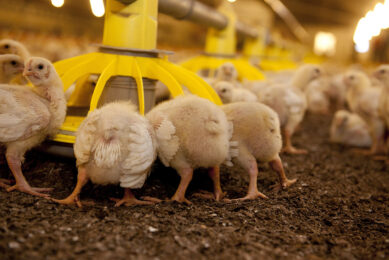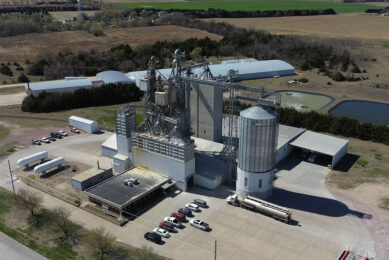Poultry expert on nutritional tools for antibiotic reduction

Functional ingredients’ specific effect on reducing antibiotic application on poultry farms has been discussed in this interview with a poultry expert, Mark Karimi.
Profile:
Mark Karimi is Agilia A/S poultry technical manager. He gained his first BSc degree in Agriculture and worked within this sector for 8 years before moving to the UK in 2000. Mark did his 2nd degree in Food Science at The University of Nottingham before joining one of the biggest poultry producers in the UK. He gained a MSc degree in Applied Poultry Science from The University of Glasgow and started his new career as a commercial poultry nutritionist. Mark’s interest is finding the best nutrition and farm management techniques to maximise productivity, health and welfare on commercial poultry farms.
Nowadays everyone is talking about poultry farming with no antibiotics whatsoever. How do you see it?
First of all, I’d like to say that probably the most important development in medical science in the last 60 years is antibiotics, not only for human treatment, but also in animal husbandry. It is very important to know that the fundamental use of antibiotics in animal husbandry is to treat sick animals. No creature deserves suffering when a solution is available to avoid it. Therefore, there is no question about the treatment of infected animals with antibiotics.
However, in poultry farming and, just on some occasions, it would be more efficient to use antibiotics for the prevention of bacterial disease too. In such cases, the birds that receive antibiotics are not infected, but the risk of infection is extremely high or even inevitable. In this case, a veterinary surgeon may decide to provide a prophylactic treatment, which of course is based on their epidemiological and clinical knowledge.
Functional ingredients with specific bioactive components, offer benefits to both health and performance of animals”
It seems you believe antibiotics must be used when needed?
Yes, you are right! However it should be used at the right time and in the right conditions. Replacing good farm management and correct nutrition with unnecessary antibiotic application is one of the worst things happening on some poultry farms at the moment. When we face a microbial problem on our farms, we need to find out what we could have done to prevent such problems occurring in the first place. We should question ourselves; have we really done enough to make our birds healthy and fit during the entire production period?
It is a fact that the genetic selection for increased bodyweight in modern broilers and turkey birds has led to a decrease in the relative weight of their primary and secondary immune organs. For sure, such a change has lowered the bird’s ability to resist diseases to the same degree as they use to. What is the farmer’s responsibility in this case? Probably keeping biosecurity tight is the first thing to do. However, this is not the only way to prevent problems. Unwanted microorganisms may find their way into a chicken house. The question is: how prepared are your birds to fight back? And, in this regard, have we provided them with the best possible environment, health plan and nutritional help to make sure they face no unnecessary stress?
Some environmental and managerial stressors, such as chick handling in the hatchery/farm, transport from the hatchery to farm, early vaccination in the hatchery/farm, etc can’t be avoided. Even some later stresses, such as heat stress, post-vaccination stress and also microbial challenges are quite hard to be avoided. However, when it comes to nutrition, I believe we have enough tools and the knowledge to support our birds.
When you say “when it comes to nutrition, we have enough tools and the knowledge to support our birds” – what do you mean by this?
Raising poultry is not new to humankind, for thousands of years we’ve raised chickens for their meat and eggs. During the last 70 years or so, when we gradually learned how to select the best breeds to grow, we also learned how to feed them to reach their full potential. Although we are still learning and far from perfection, through thousands of experiments carried out globally we have discovered many invaluable solutions for nutritional issues facing the birds. Nowadays, there are large numbers of high quality and sustainable ingredients that we can use in the feed. Among them, there are some highly digestible, functional ingredients with specific bioactive components, offering fantastic benefits to both the health and performance of animals. Poultry producers need to pick the right ones that will maximise their flock’s results.
You talked about functional ingredients. What exactly are they and how can they reduce the chance of infection on farms?
Functional ingredients are ingredients that provide health and economic benefits beyond basic nutrition. They usually contain bio-active compounds which have specific functional properties. These properties may provide solutions to recurrent challenges, rather than only focusing on growth. A particularly good example is Alphasoy Gold, a unique product that we do here at Agilia.
In 2017, our scientists started a project to create a functional, protein-rich ingredient tailored specifically to the needs of modern young poultry. The aim was to develop an affordable ingredient with both nutritional and functional properties, which help young birds to thrive and grow efficiently from the early stage of life. Agilia scientists know that soybean meal (SBM) and other unprocessed protein sources are hugely variable in consistency and quality, depending on the growing season, source of origin and also processing methods. Moreover, they know that anti-nutritional factors within conventional soybean meal sometimes reach an unbearable level. All of these factors may cause a great deal of stress to young birds. Therefore, we decided to design a process to remove all of these invariabilities as well as unlock maximum nutritional and functional value from the soybean meal. In this unique process, we managed to reduce all known ANFs to a safe level, so minimised the risk of stress caused by them. We also managed to improve digestibility of all key amino acids by up to 2% (measured in broiler birds). By increasing the digestibility of protein in the small intestine, there is less chance of protein fermentation in the bird’s caeca and large intestine, hence less chance for thriving harmful bacteria and noxious metabolite that they produce.
The Alphasoy Gold process alters the carbohydrate profile of soybean meal by reducing fermentable carbohydrates and increasing digestible ones. Such a process creates a product with a unique, healthy carbohydrate content and moreover, unlocks around 16% more energy (compared to standard SBM). The bio-active components of Alphasoy Gold support the development of an optimal gut environment and create the right condition for effective digestion and absorption of nutrients. They also boost the bird’s immune system with their unique, immune-modulatory properties. All of these properties create a healthy and efficient gut, which keeps enteric pathogens at bay.
Hopefully I have been able to give you a clear example of how we can minimise the use of antibiotics on farm by keeping the bird’s health and well-being under control. It is not an easy job, but being aware of the nutritional tools available to us makes it more achievable for sure.
Author:
Jackie Doyle, Agriculture Marketing Consultant







